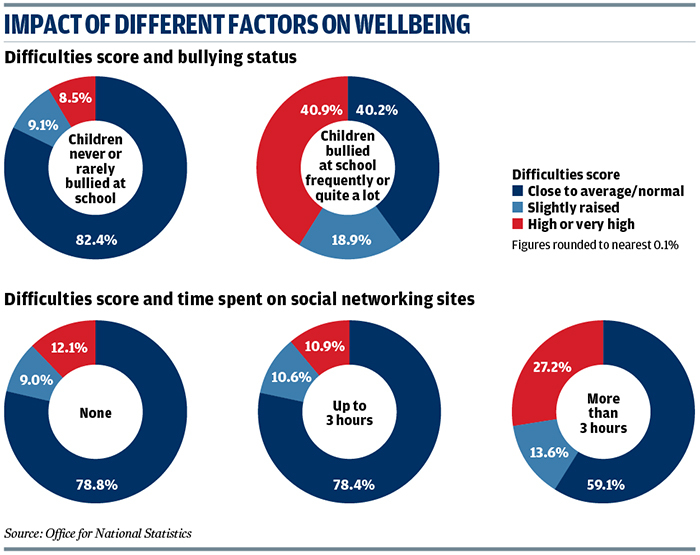Insights into Children's Mental Health and Wellbeing
Charlotte Goddard
Tuesday, November 24, 2015
Researchers examine children's self-reported data on difficulties they have in areas such as emotions, behaviour, hyperactivity or inattention, and peer relationships.
Author Rachel Beardsmore
Published by Office for National Statistics, October 2015
Report: Insights into Children's Mental Health and Wellbeing
Summary
The Office for National Statistics has introduced a measurement of mental ill-health into its most recent annual examination of children's wellbeing. The new measure combines children's self-reported data on difficulties they have in areas such as emotions, behaviour, hyperactivity or inattention, and peer relationships. The researchers took a high score in these areas of 18 or 19 out of 40 or a very high score of 20 or more out of 40 as a predictor for mental ill-health. The data is taken from the strengths and difficulties questionnaire, part of the UK Household Longitudinal Survey (Understanding Society).
The study found one in eight children aged between 10 and 15 reported symptoms of mental ill-health in 2011/12. Of the wellbeing measures available, bullying and quarrelling with mothers had the strongest associations with mental ill-health. Children who were frequently bullied were four times more likely to report a high or very high difficulties score than those who were not - 41 per cent compared with nine per cent. In addition, children who were bullied more than four times in the last six months had significantly higher average total difficulties scores at 16.2 compared with 9.8 for those children who had never been bullied or had been bullied less frequently.
More than a quarter - 27 per cent - of children reported quarrelling with their mother more than once a week in 2011/12. These children were three times more likely to report a high or very high difficulties score than children who quarrelled less frequently with their mum. Similarly, children who quarrelled with their father more than once a week were more than twice as likely to report a high or very high score than those who quarrelled less than once a week with their dad.
One third of children who were relatively unhappy with their appearance reported high or very high total difficulties score, compared with one in 12 children who were relatively happy with their appearance.
Happiness at school was also found to be linked to mental health. Children who reported being relatively unhappy with school had an average total difficulties score more than 50 per cent higher than children who reported being relatively happy with school. Children who were relatively unhappy with school were more than four times more likely to report high or very high total difficulties scores than those children who were relatively happy with school - 38 per cent compared with nine per cent.
In 2012/13, around eight per cent of children spent more than three hours on social networking websites on a typical school day - 11 per cent of girls and five per cent of boys. These children were more than twice as likely to report a high or very high difficulties score than children spending less time on social websites.
Implications for Practice
While social networking sites may provide an additional way to connect with others and form relationships, and thus boost children's mental health, the report says they could also be a source of social comparison, cyberbullying and isolation, thus reducing children's mental health. Sleep researcher Dr Heather Cleland Woods of the University of Glasgow has proposed a "digital sunset" which would enable smartphones and tablets to automatically turn off at bedtime. Others, such as the charity YoungMinds, have called for issues such as social media use and bullying to be tackled by compulsory personal, social and health education (PSHE) lessons in schools.

Further Reading
Key Data on Adolescence 2015, Association for Young People's Health, September 2015. Includes a chapter on mental health and wellbeing.
Mental Health Difficulties in Early Adolescence : A Comparison of Two Cross-Sectional Studies in England From 2009 to 2014, Elian Fink, Praveetha Patalay, Helen Sharpe, Simone Holley, Jessica Deighton, Miranda Wolpert, Journal of Adolescent Health, May 2015. An analysis finding a significant increase in emotional problems in girls and a decrease in total difficulties in boys in 2014 compared with 2009.
A Critical Review of the Literature on Children and Young People's Views of the Factors that Influence Their Mental Health, Janet Shucksmith, Jenny Spratt, Kate Philip, Rebekah McNaughton, published by NHS Health Scotland, September 2009. A roundup of research findings, part of a wider piece of work undertaken in Scotland to develop a set of mental health indicators.




